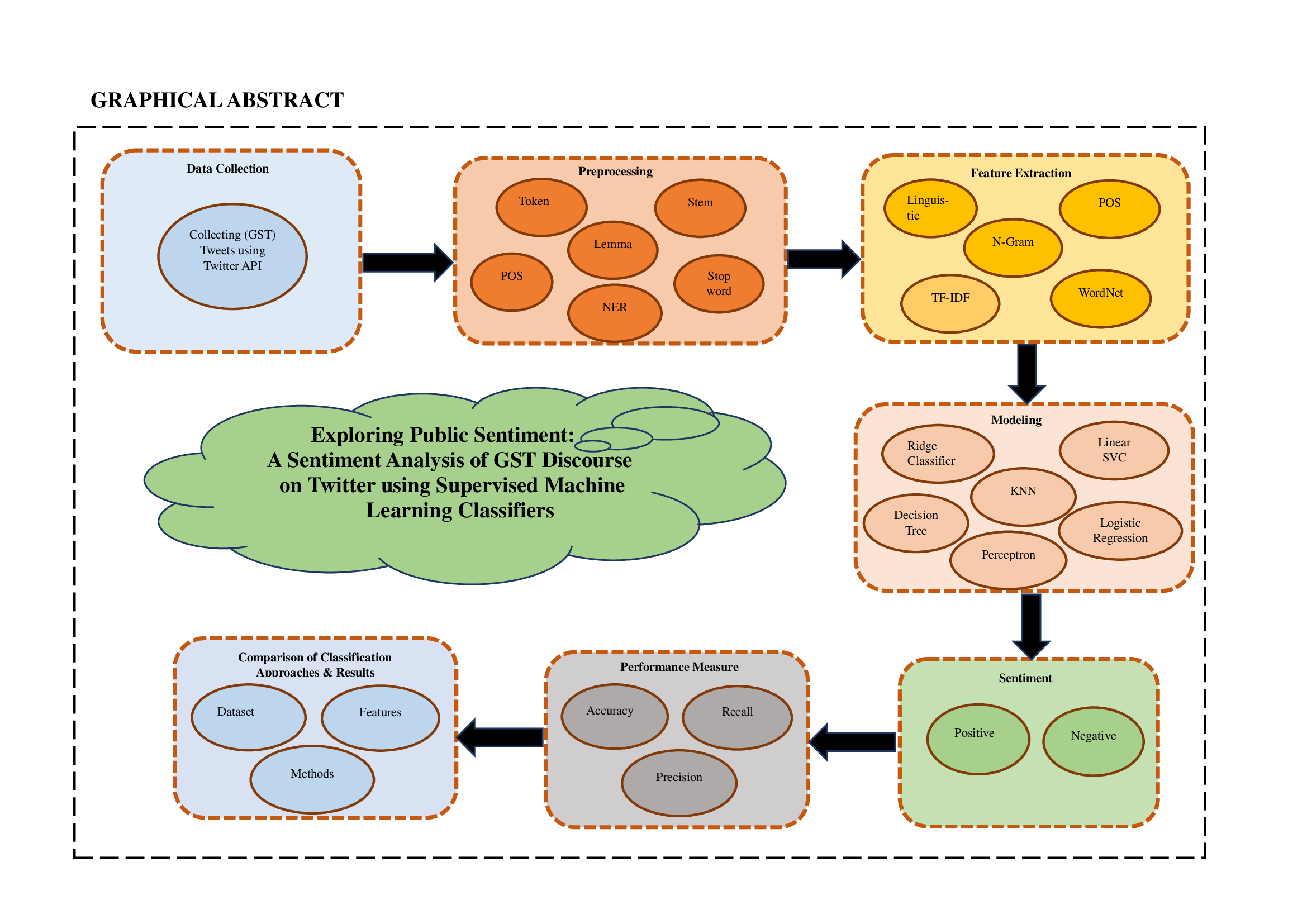Exploring Public Sentiment: A Sentiment Analysis of GST Discourse on Twitter using Supervised Machine Learning Classifiers
Main Article Content
Abstract
A key economic move that resulted in heated disputes was India's introduction of the Goods and Services Tax (GST). Social media channels offered a widely used forum for the people to express their views on the GST, providing insightful data for gauging mood and guiding next revisions. The emotion of 5629 GST-related tweets was assessed using the VADER lexicon after being obtained using the Twitter Developer API. The tf-idf feature was used for text vectorization, with 80% of the data going toward training and the remaining 20% going toward testing. In this study, six well-known classifiers—the Ridge Classifier, Logistic Regression, Linear SVC, Perceptron, Decision Tree, and K-Nearest Neighbor—were thoroughly compared to evaluate their performance in a range of circumstances. Accuracy, precision, recall, f-score, training, and testing times were all included in the performance measurements. The study presented novel pre-processing methods and examined the training/testing times before coming to the conclusion that the Ridge Classifier performed better than the others in terms of accuracy, precision, and efficiency. In this study, six well-known classifiers—the Ridge Classifier, Logistic Regression, Linear SVC, Perceptron, Decision Tree, and K-Nearest Neighbor—were thoroughly compared to evaluate their performance in a range of circumstances. Accuracy, precision, recall, f-score, training, and testing times were all included in the performance measurements. The study presented novel pre-processing methods and examined the training/testing times before coming to the conclusion that the Ridge Classifier performed better than the others in terms of accuracy, precision, and efficiency.
Article Details
References
C. Bhadane, H. Dalal, and H. Doshi, “Sentiment analysis: Measuring opinions”, International Conference on Advanced Computing Technologies and Applications (ICACTA-2015), Procedia Computer Science. Elsevier, 45: 808 – 814, (2015).https://doi.org/10.1016/j.procs.2015.03.159
T. J. Siddiqui, “Utilizing sentiments in online contextual advertising. In online multimedia advertising: Techniques and Technologies”, IGI Global, 32-37, (2011). https://doi.org/10.4018/978-1-60960-189-8.ch003
S. K. Singh, and M.K. Sachan, “SentiVerb system: Classification of social media text using sentiment analysis”, Multimedia Tools and Applications India, 78(22), 32109–32136, (2019).doi. /10.1007/s11042-019-07995
A. Pak, and P. Paroubek, “Twitter as a corpus for sentiment analysis and opinion mining”, Proceedings of the 17th conference on International Language Resources and Evaluation (LREC’10 European Language Resources Association (ELRA), Valletta, Malta. 10, No. 2010, 1320-1326, (2010). https://lexitron.nectec.or.th/public/LREC-2010_Malta
B. Liu, “Sentiment analysis and opinion mining”, Human Language Technologies (Synthesis Lectures). Morgan & Claypool Publishers, 5(1):1-67, (2012). https://www.cs.uic.edu/~liub/FBS/liub-SA-and-OM-book.pdf
B. Pang, L. Lee, and S. Vaithyanathan, “Thumbs up? Sentiment classification using machine learning techniques”, In Empirical methods in natural language processing EMNLP ’02. ACL, arXiv preprint cs/0205070, (2002). https://doi.org/10.48550/arXiv cs/0205070
Nguyen Thanh Tung, Luong Van Van. (2023). Effect of Braking Force on Wheel Load and Braking Efficiency of Tractor Semi-Trailer on A Roundabout Using Machine Learning Techniques. International Journal of Intelligent Systems and Applications in Engineering, 11(4s), 428–433. Retrieved from https://ijisae.org/index.php/IJISAE/article/view/2689
A. K. Deshmukh, A. Mohan, and I. Mohan, “Goods and services tax (GST) implementation in India: An SAP–LAP–twitter analytic perspective”, Global Journal of Flexible Systems Management, Springer, 23, 165-183, (2022). https://doi.org/10.1007/s40171-021-00297-3
S. Cnossen, “Preparing the way for a modern GST in India”, International Tax and Public Finance, Springer Science Business Media New York. 20, 715-723, (2013). https://doi.org/10.1007/s10797-013-9281-0
A. Madan, R. Arora, and N.R. Roy, “Sentiment analysis of Indians on GST”, International conference on recent developments in science, engineering and technology REDSET 2017: Gurgaon, India. Revised Selected Papers, Springer Singapore. 4, 568-575, (2017). https://doi.org/10.1007/978-981-10-8527-7_47
S. Das, and A.K. Kolya, “Sense GST: Text mining & sentiment analysis of GST tweets by naive bayes algorithm”, Third international conference on research in computational intelligence and communication network (ICRCICN). IEEE, 239-244, (2017). https://doi.org/10.1109/ICRCICN.2017.8234513
J.R. Chaudhary, and J. Paulose, “Opinion mining on newspaper headlines using SVM and NLP”, International Journal of Electrical and Computer Engineering (IJECE), 9 (3), 2152-2163, (2019).https://doi.org/ 10.11591/ijece. v9i3.pp2152- 2163
Dr. M. Varadharaj. (2019). Density Based Traffic Control System with Smart Sensing Of Emergency Vehicles. International Journal of New Practices in Management and Engineering, 8(02), 01 - 07. https://doi.org/10.17762/ijnpme.v8i02.75
M. Ganguly, and S. Roy, “A social network analysis of opinions on GST in India within twitter”, In Proceedings of the Workshop Program of the 19th International Conference on Distributed Computing and Networking, Varanasi, India. Association for Computing Machinery, ACM, 1-2, (2018). https://doi.org/10.1145/3170521.3170539
G. Gautam, and D. Yadav, “Sentiment analysis of twitter data using machine learning approaches and semantic analysis”, In Proceedings of Seventh International Conference on Contemporary Computing (IC3), IEEE, 437-442,(2014).https://doi.org/10.1109/IC3.2014.6897213
N. Tomar, R. Srivastava, and B. Ahuja, “Opinion mining of GST implementation using supervised machine learning”, International Journal of Computer Applications, 180, 1-7, (2018). https://doi.org/ 10.5120/ijca2018917283
P. Barnaghi, P. Ghaffari, and J.G. Breslin, “Opinion mining and sentiment polarity on twitter and correlation between events and sentiment”, Second International Conference on Big Data Computing Service and Applications, (Big Data Service), IEEE. 52-57, (2016). https://doi.org/10.1109/BigDataService.2016.36
P. D. Turney, “Thumbs up or thumbs down? Semantic orientation applied to unsupervised classification of reviews”, In Proceedings of the 40th Annual Meeting of the Association for Computational Linguistics (ACL), arXiv preprint cs/0212032, (2002). https://doi.org/10.48550/arXiv.cs/0212032
Waheeb , M. Q. ., SANGEETHA, D., & Raj , R. . (2021). Detection of Various Plant Disease Stages and Its Prevention Method Based on Deep Learning Technique. Research Journal of Computer Systems and Engineering, 2(2), 33:37. Retrieved from https://technicaljournals.org/RJCSE/index.php/journal/article/view/30
M. Hall, E. Frank, G. Holmes, B. Pfahringer, P. Reutemann and I.H. Witten, “The WEKA data mining software: an update”, ACM SIGKDD Explorations newsletter.11 (1), 10-18, (2009).
M.D. Devika, C. Sunitha, and A. Ganesh, “Sentiment Analysis: A comparative study on different approaches”, Procedia Computer Science, Elsevier, 87, 44–49, (2016). https://doi.org/10.1016/j.procs.2016.05.124.
S. Bird, E. Klein, and E. Loper, “Natural language processing with python – analyzing text with the natural language toolkit”, O’Reilly Media, Inc. (2009), https://www.nltk.org/book/
A. Go, R. Bhayani, and L. Huang, “Twitter sentiment classification using distant supervision”, CS224N Project Report, Stanford,1(12), p.2009, (2009). https://nlp.stanford.edu/courses/cs224n/2009/fp/3.pdf

